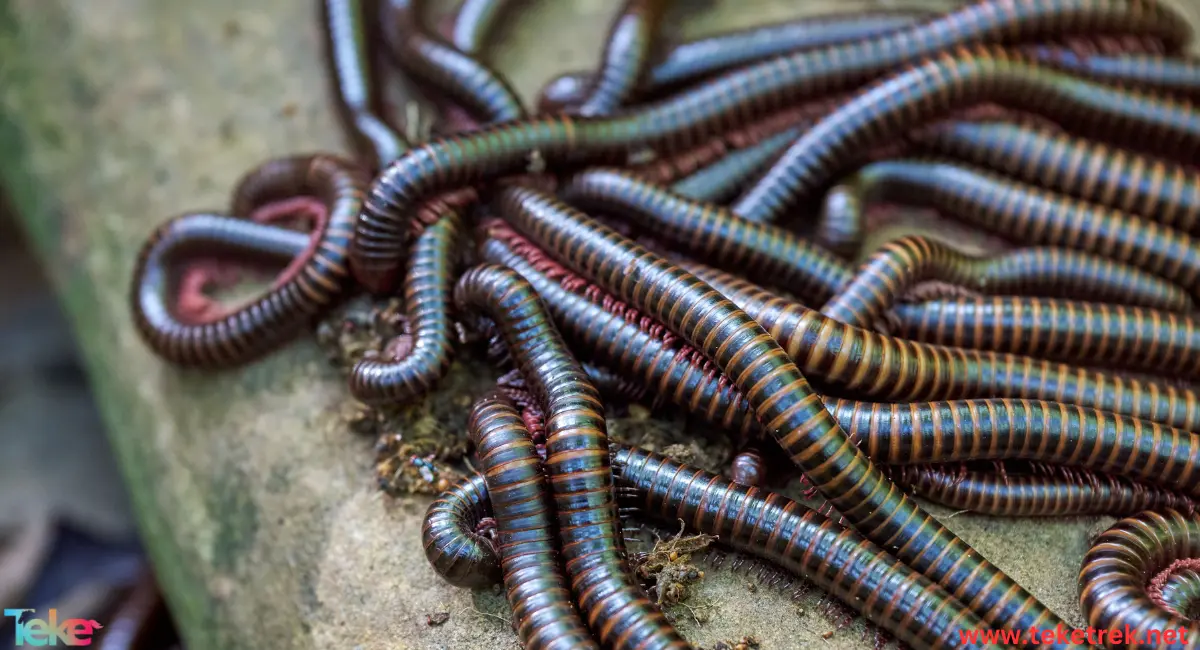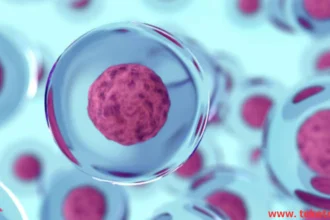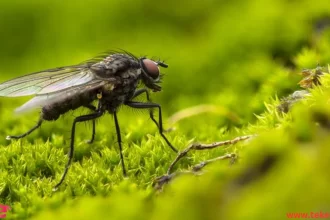Tapeworms are intestinal parasites that resemble a measuring tape. Their eggs usually enter a human or animal host through food, especially raw or undercooked meat. In this article from teketrek, we will talk about tapeworms, their life cycle, how they infect, and how to treat them.

What are tapeworms?
Tapeworms are parasites that live inside another organism, known as the host.
Tapeworms grow after the host swallows the tapeworm’s eggs.
Humans can get tapeworms by :
Drinking contaminated water. Interacting with infected animals or contaminated soil. Eating contaminated food. Eating infected meat or fish.
The adult tapeworm can: Live for up to 25 years. Reach a length of 50 feet.Adheres to intestine walls.
Tapeworms belong to the phylum of flatworms, family of cestodes.
The external characteristics of the tapeworm:
The tapeworm contains 3 identifiable parts:
The head: works as an attachment organ that connects to the intestinal mucous membrane. Neck: Dust off an undivided area that can regenerate significantly. If the treatment does not remove the neck and the scolex, the entire worm may regenerate.
The rest of the worm consists of many proglottids (segments). The segment closest to the neck is undifferentiated.
As the segments move tailward, each develops hermaphroditic sexual organs.
The distant proglottids are gravid and contain eggs in the uterus. Mature proglottids contain one ovary, and it is noted that the eggs can be seen under a microscope.
The size and shape vary according to the species and maturity.”
the life stages of tapeworms:
All tapeworms go through three stages:
Eggs, Larvae, and Adults : Adults reside in the intestines of definitive hosts, which are carnivorous mammals, including humans.
Many adult tapeworms that infect humans are named after their primary intermediate host (fish tapeworms, beef tapeworms, pork tapeworms).
Tapeworm infections spread when eggs laid by adult tapeworms in the intestines of a definitive host are excreted with feces into the environment and swallowed by an intermediate host.
The eggs hatch into larvae, which develop and enter the bloodstream of the intermediate host. They encyst in muscles or other organs.
When the definitive host eats the intermediate host, the parasites are released from the ingested cysts into the intestine, where they develop into adult tapeworms, and the cycle repeats.
Tapeworms are flat, segmented worms. They lack a digestive system and directly absorb nutrients from the host’s small intestine.
In the host’s digestive system, adult tapeworms can grow quite large. The longest known tapeworm is the whale tapeworm , which can reach a length of 40 meters .
Feeding of tapeworms :
1. Digested Food : Tapeworms feed on digested food available in the host’s intestines. After digestion occurs in the stomach and small intestine, the tapeworm absorbs the nutrients directly from the host’s body.
2. Regurgitation and Feces : Some internal tapeworms obtain nourishment by ingesting regurgitated or fecal matter produced by the host animal. They can break down remaining materials in the feces and utilize them as a food source.
Living Tissues : Some internal worms live on the tissue of organs inside the host animal. They absorb nutrients and fluids from the tissues they inhabit. They rely on this source for their growth and sustainability.
How can one get infected with tapeworms?
Infection with tapeworms can occur through:
Exposure to Animals : This is particularly important in areas where feces are not disposed of properly.
Difficulty Maintaining Cleanliness : If a person does not wash their hands frequently, the risk of transferring the infection to their mouth is greater.
Traveling to or Living in Certain Parts of the World : In some countries and parts of countries where it is difficult to maintain cleanliness, the risk of tapeworm transmission is higher.
Consuming Raw or Undercooked Meat and Fish : Larvae and eggs present in meats and fish can transmit tapeworms to people if consumed raw or undercooked.
Experts say sushi is safe if it has been previously frozen.
The risk of contamination from fish mainly lies in freshwater fish.

Types of Tapeworms :
In humans, tapeworm infections most often come from the following species:
– Pork Tapeworm (Taenia solium).
– Beef Tapeworm (Taenia saginata).
– Dwarf Tapeworm (Hymenolepis nana).
– Fish Tapeworm from raw freshwater fish (Diphyllobothrium latum).
– Dog Tapeworm . More common in rural areas.
The type of tapeworm will affect the infected area of the body and the severity of symptoms.
How to prevent tapeworm infection?
There are several effective ways to help prevent tapeworm infection, including:
Maintaining Cleanliness : Wash hands well with soap and water after using the bathroom, touching animals and insects, and before eating.
Food Precautions: Make sure to wash and cook all fruits and vegetables with clean water.
Livestock : Properly dispose of animal and human feces. Minimize animals’ exposure to tapeworm eggs.
Meat : Cook meat to a temperature of at least 150 degrees Fahrenheit (66 degrees Celsius). This will kill larvae or eggs.
Meat and fish: Freeze for at least 7 days to kill tapeworm eggs and larvae.
Experts say that smoking or drying meats or fish is not a reliable way to kill larvae or eggs.
Raw Foods : Do not consume raw pork, beef, or fish.
Dogs : If a person has a dog, they should make sure the dog is treated for tapeworms. Personal hygiene should also be taken care of.They may want to ensure that the dog only eats cooked meats and fish, in case they are given that.
Surfaces : Make sure to regularly clean and disinfect all frequently touched areas.
Advanced Symptoms of Tapeworm Infection
Advanced tapeworm infections can cause a wide range of symptoms, which vary depending on the location of the worms in the body.
In some cases, no noticeable symptoms appear, but in others, symptoms such as abdominal pain, weight loss, intestinal inflammation, nausea, vomiting, diarrhea, and the presence of worm segments or eggs in the stool may occur.
If the worms migrate to other organs, such as the brain, they may cause more severe symptoms like headaches, seizures, dizziness, changes in thinking or behavior, and even serious neurological problems such as coma.
When the tapeworm spreads to other areas, it can cause problems in the affected organs, such as liver, lung, or heart diseases. Lumps may form, leading to pain or swelling.
When Should You See a Doctor? Warning Signs Not to Ignore
You should see a doctor if you experience any of the following warning signs, especially if they persist or worsen: persistent chest pain, difficulty breathing, severe abdominal pain, vision changes, problems with balance or speech, sudden changes in personality or memory, unexplained bleeding, persistent fever, extreme fatigue, or any pain that does not respond to painkillers.
The Link Between Tapeworms and Malnutrition
There is a strong connection between tapeworm infections and malnutrition. Tapeworms, as intestinal parasites, cause malnutrition by competing with the host (the human) for nutrients.
Tapeworms live in the intestines and feed on the food consumed by the infected person. This means that part of the food the person eats goes directly to the tapeworm instead of being absorbed by the body. As a result, fewer nutrients, vitamins, and minerals are absorbed.
This nutritional deficiency can lead to anemia, poor growth, and other health problems associated with malnutrition.
Additionally, tapeworm-related malnutrition can affect growth and development, especially in children, and may lead to chronic health problems.
What Is the Difference Between Tapeworms and Roundworms?
The main difference between tapeworms and roundworms lies in their body shape. Tapeworms are flat and ribbon-like, while roundworms are cylindrical with a rounded shape.
Here is a detailed comparison:
Tapeworms (Platyhelminthes):
- Shape: Flat, long, and ribbon-like.
- Symmetry: Bilateral symmetry (can be divided into two identical halves by one line).
- Digestive system: Incomplete or absent in some species.
- Reproduction: Hermaphroditic (contain both male and female reproductive organs in the same organism).
- Examples: Beef tapeworm, pork tapeworm.
Roundworms (Nematoda):
- Shape: Cylindrical, long, and round (not flat).
- Symmetry: Bilateral symmetry.
- Digestive system: Complete (has a mouth and anus).
- Reproduction: Separate sexes (males and females are distinct).
- Examples: Ascaris worm, pinworm.
Can Tapeworms Be Transmitted from Person to Person?
Yes, some types of tapeworms can be transmitted from person to person. The dwarf tapeworm is one such type, as its entire life cycle can occur in a single human host.
Additionally, tapeworms can spread through contact with the feces of an infected person or through food and water contaminated with tapeworm eggs.
Not washing hands properly after using the toilet or before handling food can also lead to the transmission of tapeworms.
Safe Travel Tips to Areas Where Tapeworms Are Common
To reduce the risk of tapeworm infection when traveling to high-risk areas, strict food and hygiene precautions must be taken. These include:
- Washing fruits and vegetables thoroughly.
- Avoiding raw or undercooked meats.
- Washing hands regularly.
- Ensuring the drinking water is safe—preferably bottled or boiled water.
- Treating pets for parasites.
- Avoiding swimming or diving in waters that may be contaminated with animal or human feces.
Can Humans Get Tapeworms from Pets?
Yes, humans can get tapeworms from pets, especially dogs and cats, but this usually occurs in rare cases.
Dogs and cats can carry tapeworms and transmit them to humans through contaminated feces or via fleas that ingest tapeworm eggs. Humans may become infected if they accidentally swallow these fleas.
Precautions to prevent infection include:
- Maintaining good hygiene.
- Controlling fleas on pets.
- Ensuring overall health and cleanliness.
- Preventing pets from eating feces or roaming in dirty areas.
- Regularly having pets examined by a veterinarian to ensure they are free of worms.
Frequently Asked Questions about Tapeworms :
- How is Tapeworm Infection Diagnosed?
Tapeworm infection can be diagnosed through:
- Examination of stool samples to look for tapeworm segments or eggs.
- Physical examination of the patient to detect signs or symptoms of tapeworm infection.
- Medical imaging tests such as X-rays or ultrasound imaging.
Laboratory analysis of stool samples to detect tapeworm eggs or other signs of infection.
- After diagnosis, the doctor can develop a treatment plan
.
- How Do I Know If I Have Tapeworms?
You can detect the presence of tapeworms by monitoring the following symptoms:
- Unexplained weight loss.
- Presence of tapeworm segments in stool.
- Abdominal muscle cramps.
- Nausea and frequent vomiting.
- Itching in the anal area.
- How Long Do Tapeworms Live in the Human Body?
Tapeworms can live in the body for a period ranging from a few months to several years.
- Do Tapeworms Come out with Stool?
Yes, tapeworms usually come out with stool when they reach maturity.
- Are Tapeworms Harmful?
Yes, tapeworms can be harmful to humans, causing health problems such as digestive disorders, malnutrition, formation of worm masses, and internal organ infections.
- Can You Feel Tapeworm Movement?
Usually, people do not feel the movement of tapeworms inside their intestines. Tapeworms are small enough to not be felt by the person as they move inside the body.
In conclusion, tapeworms are intestinal parasites that can live inside another animal or plant. They are more prevalent in parts of the world where maintaining cleanliness is difficult. They may be consumed when eating raw or undercooked meat and fish.
Sources





